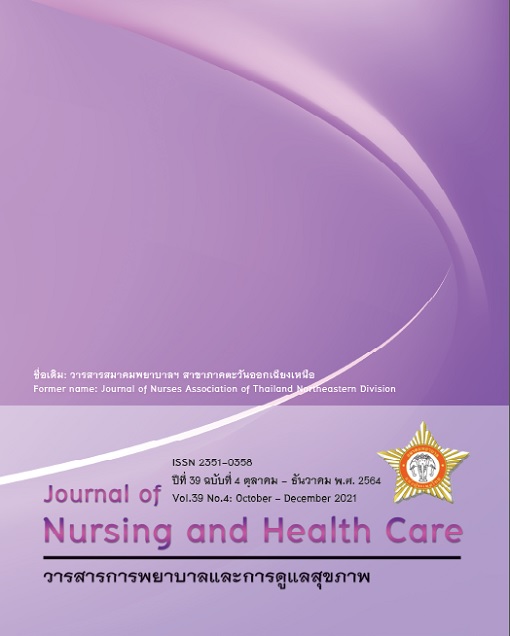The ผลของโปรแกรมปรับเปลี่ยนพฤติกรรมเสี่ยงด้านสุขภาพ ร่วมกับการเสริมพลังด้วยกลุ่มเพื่อนคู่คิด ในกลุ่มบุคลากร โรงพยาบาลอำนาจเจริญ ที่มีดัชนีมวลกายเกิน
คำสำคัญ:
เพื่อนคู่คิด องค์ประกอบของร่างกาย ดัชนีมวลกายเกินบทคัดย่อ
การวิจัยกึ่งทดลองแบบกลุ่มเดียววัดผลก่อนและหลังครั้งนี้ มีวัตถุประสงค์เพื่อศึกษาผลของโปรแกรมปรับเปลี่ยนพฤติกรรมเสี่ยงด้านสุขภาพร่วมกับการเสริมพลังด้วยกลุ่มเพื่อนคู่คิด ในกลุ่มบุคลากร โรงพยาบาลอำนาจเจริญ ที่มีดัชนีมวลกายเกิน 83 คน กลุ่มตัวอย่างได้รับ 1) เสริมสมรรถนะโดยการอบรมทักษะการปรับเปลี่ยนพฤติกรรม 2) กระบวนการบำบัดโดยกลุ่มเพื่อนคู่คิด 3) กำกับตนเอง โดยบันทึกพฤติกรรมในสมุดมิตรคู่ใจ 4) สร้างแรงสนับสนุนทางสังคม ด้วยการถอดบทเรียนเสริมกำลังใจโดยกลุ่มเพื่อน 5) ประเมินความก้าวหน้าพฤติกรรมและน้ำหนัก โดยกลุ่มเพื่อน เป็นระยะเวลา 6 เดือน เก็บรวบรวมข้อมูลด้วยแบบสอบถามที่ผู้วิจัยสร้างขึ้น มีค่าความเชื่อมั่นเท่ากับ 0.84 และตรวจองค์ประกอบร่างกายด้วยเครื่อง Inbody วิเคราะห์ข้อมูลด้วยสถิติเชิงพรรณนา และสถิติเชิงอนุมานด้วย Paired Sample t-test และ Wilcoxon Signed Rank Test
ผลการศึกษาพบว่า กลุ่มตัวอย่างมีอัตราคงอยู่ร้อยละ 75.9 ส่วนใหญ่เป็นเพศหญิง อายุเฉลี่ย 42.66±9.69 ปี ระดับการศึกษาปริญญาตรีหรือสูงกว่า เป็นบุคลากรสายวิชาชีพ ภายหลังการทดลอง พฤติกรรมสุขภาพ ค่าดัชนีมวลกาย เปอร์เซ็นต์ไขมัน และไขมันในช่องท้องเกินอยู่ในเกณฑ์ปกติเพิ่มขึ้น เมื่อเปรียบเทียบระหว่างก่อนและหลังการทดลอง พบว่า พฤติกรรมส่งเสริมสุขภาพ (p-value<.001) และองค์ประกอบร่างกาย ประกอบด้วย น้ำหนัก (p-value<.001) ดัชนีมวลกาย (p-value<.001) เปอร์เซ็นต์ไขมัน (p-value=.003) และไขมันในช่องท้อง (p-value=.001) แตกต่างจากก่อนการทดลองอย่างมีนัยสำคัญทางสถิติ
Downloads
เอกสารอ้างอิง
2. Kitworapatn V. Fight for Obesity, Fight for Metabolic Syndrome.Bangkok: National Office of Buddhism Printing, 2010.
3. World Health Organization. Obesity and overweight [Online] [cited 2019 July 16]. Available from: http://www.who.int/mediacentre/factsheets/fs311/en/print.html. 2019.
4. World Health Organization. Obesity and overweight [Online]. [cited 2019 July]. Available from: http://www.who.int/mediacentre/factsheets., 2014
5. Institute for Population and Social Research. Thai Health 2014: How fat is Thai people?. Nokornprathom: Mahidol University, 2014.
6. Department of Health, Public Health Ministry. Fight for Obesity, Fight for Metabolic Syndrome. Bangkok: National Office Of Buddhism Printing, 2012.
7. Khamchata L., Dumrongpakapakorn P., Theeranut A. Metabolic Syndrome: Dangerous Signs Required Management. Srinagarind Med J 2018; 33(4): 386-95.
8. Ravinit P., Sudthum A. Factor Associated with the Metabolic Syndrome in Chamab Sub-district, Wang Noi District, Ayutthaya Province. APHEIT Journal 2017; 5(2): 33-47.
9. World Health Organization. Obesity: preventing and managing the global epidemic. Geneva, Switzerland: World Health Organization; 2000.
10. Khuneepong A. Predicting Factors of Overweight Prevention Behaviors among Graduate Students. Journal of Safety and Health 2017; 10(37): 58-66.
11. Amnatchareon Hospital. Annual Report 2018. Amnatchareon Province: Amnatchareon Hospital, 2019.
12. Samart S., Sota C. The Effectiveness of Health Education Program Applying Self-efficacy and Stages of Change for Weight Reduction among Working Age40-49 Years Old Group with Overweight and Obesityin Nongkungshern Subdistrict, Phuwiang District, Khon Kaen Province. Journal of The Office of ODPC 7 Khon Kaen 2016; 23(3): 34-45.
13. Phanphom P., Rodjakpai Y., Wirutsettasin K. The Results of the Weight-Control Program on Applying the Concept of Self-Regulation towards Body Mass Index of People with Overweight in Bothong District, Chonburi Province. Journal of Public Health Nursing 2017; 30(1): 44-59.
14. Layanun P. Effectiveness of Self-regulation for Health Behavioral Modification of Personnel at Risk of Obesity Lerdsin Hospital. Journal of Nursing Division 2012; 39(3): 21-37.
15. Palapol T., Suwonaroop N., Ruangjiratain S. The Effect of Enhancing Perceived Self-Efficacy Program on Food Consumption and Exercise Behavior in Adults at Risk for Metabolic Syndrome. Journal of Nursing Science Chulalongkorn University 2017; 29(1): 81-91.
16. Kuanra-ngub S. Behavior Modification Program for Weight Control of Payap University Personnel. Nursing Journal 2014; 41(1): 85-95.
17. Samanchat P., Waleekhachonloet O., Towanna B. Effect of the Weight Control Program Focusing on the Modification of Eating Behavior in the Overweight or Obese University Students. Thai Journal of Pharmacy Practice 2010; 2(1): 35-45.
18. Ponghan P., Suntayakorn C., Prachanban P., Wannapira W. Effects of Health Promotion Program on Metabolic Syndrome Preventive Behaviors among Health Volunteers. Journal of Nursing and Health Sciences 2011; 5(3): 54-64.
19. Zimmerman, B.J. A Social cognitive view of self-regulated academic learning. Journal of Education Perspective Educational Psychologist 1989; 29: 217-21.
20. Prasertjirt.Urban Lifestyle of Working Age Affecting Metabolic Obesity: A Case Study of Vajira Hospital College. Vajira Med J 2019; 63(suppl): 211-2.
21. Chaimay B., Woradet S. Factors Related to Metabolic Syndrome among Students in Thaksin University, Phatthalung Campus.The Public Health Journal of Burapha University 2015; 10(2): 55-65.
22. Prateepmanowong J., Sasat S. Effects of Health Behaviour Change Programme on Food Consumption and Exercise Behaviour in Older Overweight Patients with Coronary Artery Disease. Kuakarun Journal of Nursing 2018; 25(1): 106-22.
23. Kaewrattanaamporn N., Pavadhul P, Suwat Srisorrachat, Rewadee Chongsuwat. Prevalence of Metabolic Syndrome and Associated Factors Among Night Time Male Operators in Automotive Industry. Journal of Health Education 2014; 37(127): 83-97.
24. Rongmuang D. et all. The Effect of Hula Hoop Exercise, Abdominal Training and Daily Calorie Limit on Body Weight, Waist Circumference, Body Fat Percent, and Body Mass Index among Overweight Nursing Students. Journal of Nursing and Education 2013; 6(Special): 77-88.
25. Kirkendoll, K., et al. Metabolic Syndrome in African Americans: Views on Making Lifestyle Changes. Journal of Transcultural Nursing 2010; 21(2): 104-13.
26. Saetew P., Teepapal T. Development of health promotion programs to reduce the weight of student nurses Boromarajonani College of Nursing Suratthani are overweight. Journal of Nursing and Education 2016; 9(3): 80-94.
27. Changbunjong T. Effects of Application of Pilates Exercise Program on Body Mass Index and Fat Percentage of Undergraduate Student Overweight. Journal of Suvarnabhumi Institute of Technology (Humanities and Social Science) 2020; 6(1): 193-203.
28. Thitprapai P., Pansila W. Effect of self-efficacy program with the 351 technics for losses weight for, overweight and obesity for health staff in Kalasin Hospital, Muang district, Kalasin province. J Med Health Sci 2017; 24(3): 22-32.
29. Vaayeeta R., Ruangdej Chaosuansreecharoen K., Boonsit Chaichana B., Chaosuansreecharoen P. Effectiveness of a Health Behavior Change Program on Self efficacy, Self-regulation, Self-care and Weight loss among overweight Health Personal of Raman Hospital, Yala Province. Nursing Journal of the Ministry of Public Health 2017; 31(1): 90-104.



